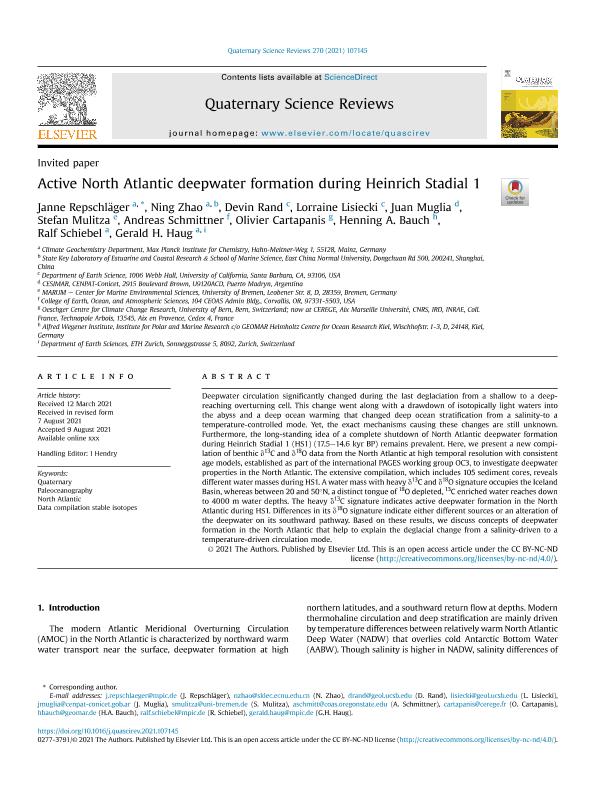Mostrar el registro sencillo del ítem
dc.contributor.author
Repschläger, Janne
dc.contributor.author
Zhao, Ning
dc.contributor.author
Rand, Devin
dc.contributor.author
Lisiecki, Lorraine
dc.contributor.author
Muglia, Juan

dc.contributor.author
Mulitza, Stefan
dc.contributor.author
Schmittner, Andreas
dc.contributor.author
Cartapanis, Olivier
dc.contributor.author
Bauch, Henning A.
dc.contributor.author
Schiebel, Ralf
dc.contributor.author
Haug, Gerald H.
dc.date.available
2022-06-10T16:39:37Z
dc.date.issued
2021-10
dc.identifier.citation
Repschläger, Janne; Zhao, Ning; Rand, Devin; Lisiecki, Lorraine; Muglia, Juan; et al.; Active North Atlantic deepwater formation during Heinrich Stadial 1; Elsevier Science SA; Quaternary Science Reviews; 270; 107145; 10-2021; 1-19
dc.identifier.issn
0277-3791
dc.identifier.uri
http://hdl.handle.net/11336/159490
dc.description.abstract
Deepwater circulation significantly changed during the last deglaciation from a shallow to a deep reaching overturning cell. This change went along with a drawdown of isotopically light waters into the abyss and a deep ocean warming that changed deep ocean stratification from a salinity-to a temperature-controlled mode. Yet, the exact mechanisms causing these changes are still unknown. Furthermore, the long-standing idea of a complete shutdown of North Atlantic deepwater formation during Heinrich Stadial 1 (HS1) (17.5e14.6 kyr BP) remains prevalent. Here, we present a new compi lation of benthic d13C and d18O data from the North Atlantic at high temporal resolution with consistent age models, established as part of the international PAGES working group OC3, to investigate deepwater properties in the North Atlantic. The extensive compilation, which includes 105 sediment cores, reveals different water masses during HS1. A water mass with heavy d13C and d18O signature occupies the Iceland Basin, whereas between 20 and 50 N, a distinct tongue of 18O depleted, 13C enriched water reaches down to 4000 m water depths. The heavy d13C signature indicates active deepwater formation in the North Atlantic during HS1. Differences in its d18O signature indicate either different sources or an alteration of the deepwater on its southward pathway. Based on these results, we discuss concepts of deepwater formation in the North Atlantic that help to explain the deglacial change from a salinity-driven to a temperature-driven circulation mode.
dc.format
application/pdf
dc.language.iso
eng
dc.publisher
Elsevier Science SA

dc.rights
info:eu-repo/semantics/openAccess
dc.rights.uri
https://creativecommons.org/licenses/by-nc-nd/2.5/ar/
dc.subject
QUATERNARY
dc.subject
PALEOCEANOGRAPHY
dc.subject
NORTH ATLANTIC
dc.subject
DATA COMPILATION STABLE ISOTOPES
dc.subject.classification
Oceanografía, Hidrología, Recursos Hídricos

dc.subject.classification
Ciencias de la Tierra y relacionadas con el Medio Ambiente

dc.subject.classification
CIENCIAS NATURALES Y EXACTAS

dc.title
Active North Atlantic deepwater formation during Heinrich Stadial 1
dc.type
info:eu-repo/semantics/article
dc.type
info:ar-repo/semantics/artículo
dc.type
info:eu-repo/semantics/publishedVersion
dc.date.updated
2021-12-13T19:20:46Z
dc.journal.volume
270
dc.journal.number
107145
dc.journal.pagination
1-19
dc.journal.pais
Estados Unidos

dc.journal.ciudad
Nueva York
dc.conicet.avisoEditorial
© 2021 The Authors. Published by Elsevier Ltd. This is an open access article under the CC BY-NC-ND license (http://creativecommons.org/licenses/by-nc-nd/4.0/).
dc.description.fil
Fil: Repschläger, Janne. Max Planck Institute For Chemistry; Alemania
dc.description.fil
Fil: Zhao, Ning. Max Planck Institute For Chemistry; Alemania. East China Normal University; China
dc.description.fil
Fil: Rand, Devin. University Of California, Santa Barbara; Estados Unidos
dc.description.fil
Fil: Lisiecki, Lorraine. University Of California, Santa Barbara; Estados Unidos
dc.description.fil
Fil: Muglia, Juan. Consejo Nacional de Investigaciones Científicas y Técnicas. Centro Científico Tecnológico Conicet - Centro Nacional Patagónico. Centro para el Estudio de Sistemas Marinos; Argentina
dc.description.fil
Fil: Mulitza, Stefan. Universitat Bremen; Alemania
dc.description.fil
Fil: Schmittner, Andreas. College of Earth, Ocean, and Atmospheric Sciences; Estados Unidos
dc.description.fil
Fil: Cartapanis, Olivier. University of Bern; Suiza
dc.description.fil
Fil: Bauch, Henning A.. Institute for Polar and Marine Research c/o GEOMAR Helmholtz Centre for Ocean Research Kiel; Alemania
dc.description.fil
Fil: Schiebel, Ralf. Max Planck Institute for Chemistry; Alemania
dc.description.fil
Fil: Haug, Gerald H.. Max Planck Institute for Chemistry; Alemania. Department of Earth Sciences; Suiza
dc.journal.title
Quaternary Science Reviews

dc.relation.alternativeid
info:eu-repo/semantics/altIdentifier/doi/http://dx.doi.org/10.1016/j.quascirev.2021.107145
dc.relation.alternativeid
info:eu-repo/semantics/altIdentifier/url/https://www.sciencedirect.com/science/article/pii/S0277379121003528?via%3Dihub
Archivos asociados
